Jongwoo Lim
SC-Lane: Slope-aware and Consistent Road Height Estimation Framework for 3D Lane Detection
Aug 14, 2025Abstract:In this paper, we introduce SC-Lane, a novel slope-aware and temporally consistent heightmap estimation framework for 3D lane detection. Unlike previous approaches that rely on fixed slope anchors, SC-Lane adaptively determines the fusion of slope-specific height features, improving robustness to diverse road geometries. To achieve this, we propose a Slope-Aware Adaptive Feature module that dynamically predicts the appropriate weights from image cues for integrating multi-slope representations into a unified heightmap. Additionally, a Height Consistency Module enforces temporal coherence, ensuring stable and accurate height estimation across consecutive frames, which is crucial for real-world driving scenarios. To evaluate the effectiveness of SC-Lane, we employ three standardized metrics-Mean Absolute Error(MAE), Root Mean Squared Error (RMSE), and threshold-based accuracy-which, although common in surface and depth estimation, have been underutilized for road height assessment. Using the LiDAR-derived heightmap dataset introduced in prior work [20], we benchmark our method under these metrics, thereby establishing a rigorous standard for future comparisons. Extensive experiments on the OpenLane benchmark demonstrate that SC-Lane significantly improves both height estimation and 3D lane detection, achieving state-of-the-art performance with an F-score of 64.3%, outperforming existing methods by a notable margin. For detailed results and a demonstration video, please refer to our project page:https://parkchaesong.github.io/sclane/
4D Gaussian Splatting in the Wild with Uncertainty-Aware Regularization
Nov 13, 2024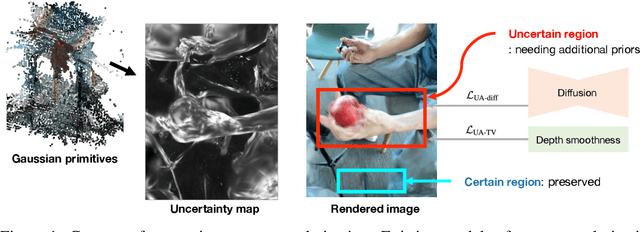



Abstract:Novel view synthesis of dynamic scenes is becoming important in various applications, including augmented and virtual reality. We propose a novel 4D Gaussian Splatting (4DGS) algorithm for dynamic scenes from casually recorded monocular videos. To overcome the overfitting problem of existing work for these real-world videos, we introduce an uncertainty-aware regularization that identifies uncertain regions with few observations and selectively imposes additional priors based on diffusion models and depth smoothness on such regions. This approach improves both the performance of novel view synthesis and the quality of training image reconstruction. We also identify the initialization problem of 4DGS in fast-moving dynamic regions, where the Structure from Motion (SfM) algorithm fails to provide reliable 3D landmarks. To initialize Gaussian primitives in such regions, we present a dynamic region densification method using the estimated depth maps and scene flow. Our experiments show that the proposed method improves the performance of 4DGS reconstruction from a video captured by a handheld monocular camera and also exhibits promising results in few-shot static scene reconstruction.
HeightLane: BEV Heightmap guided 3D Lane Detection
Aug 15, 2024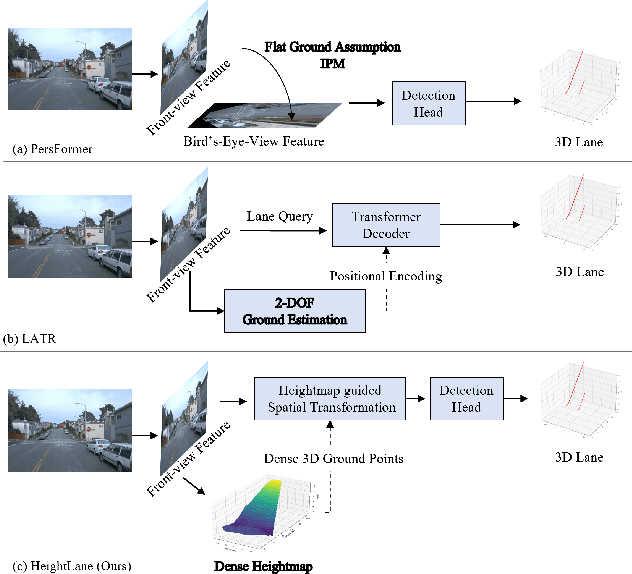



Abstract:Accurate 3D lane detection from monocular images presents significant challenges due to depth ambiguity and imperfect ground modeling. Previous attempts to model the ground have often used a planar ground assumption with limited degrees of freedom, making them unsuitable for complex road environments with varying slopes. Our study introduces HeightLane, an innovative method that predicts a height map from monocular images by creating anchors based on a multi-slope assumption. This approach provides a detailed and accurate representation of the ground. HeightLane employs the predicted heightmap along with a deformable attention-based spatial feature transform framework to efficiently convert 2D image features into 3D bird's eye view (BEV) features, enhancing spatial understanding and lane structure recognition. Additionally, the heightmap is used for the positional encoding of BEV features, further improving their spatial accuracy. This explicit view transformation bridges the gap between front-view perceptions and spatially accurate BEV representations, significantly improving detection performance. To address the lack of the necessary ground truth (GT) height map in the original OpenLane dataset, we leverage the Waymo dataset and accumulate its LiDAR data to generate a height map for the drivable area of each scene. The GT heightmaps are used to train the heightmap extraction module from monocular images. Extensive experiments on the OpenLane validation set show that HeightLane achieves state-of-the-art performance in terms of F-score, highlighting its potential in real-world applications.
Integrating Meshes and 3D Gaussians for Indoor Scene Reconstruction with SAM Mask Guidance
Jul 23, 2024Abstract:We present a novel approach for 3D indoor scene reconstruction that combines 3D Gaussian Splatting (3DGS) with mesh representations. We use meshes for the room layout of the indoor scene, such as walls, ceilings, and floors, while employing 3D Gaussians for other objects. This hybrid approach leverages the strengths of both representations, offering enhanced flexibility and ease of editing. However, joint training of meshes and 3D Gaussians is challenging because it is not clear which primitive should affect which part of the rendered image. Objects close to the room layout often struggle during training, particularly when the room layout is textureless, which can lead to incorrect optimizations and unnecessary 3D Gaussians. To overcome these challenges, we employ Segment Anything Model (SAM) to guide the selection of primitives. The SAM mask loss enforces each instance to be represented by either Gaussians or meshes, ensuring clear separation and stable training. Furthermore, we introduce an additional densification stage without resetting the opacity after the standard densification. This stage mitigates the degradation of image quality caused by a limited number of 3D Gaussians after the standard densification.
Unbiased Estimator for Distorted Conics in Camera Calibration
Mar 10, 2024Abstract:In the literature, points and conics have been major features for camera geometric calibration. Although conics are more informative features than points, the loss of the conic property under distortion has critically limited the utility of conic features in camera calibration. Many existing approaches addressed conic-based calibration by ignoring distortion or introducing 3D spherical targets to circumvent this limitation. In this paper, we present a novel formulation for conic-based calibration using moments. Our derivation is based on the mathematical finding that the first moment can be estimated without bias even under distortion. This allows us to track moment changes during projection and distortion, ensuring the preservation of the first moment of the distorted conic. With an unbiased estimator, the circular patterns can be accurately detected at the sub-pixel level and can now be fully exploited for an entire calibration pipeline, resulting in significantly improved calibration. The entire code is readily available from https://github.com/ChaehyeonSong/discocal.
TSDF-Sampling: Efficient Sampling for Neural Surface Field using Truncated Signed Distance Field
Nov 29, 2023Abstract:Multi-view neural surface reconstruction has exhibited impressive results. However, a notable limitation is the prohibitively slow inference time when compared to traditional techniques, primarily attributed to the dense sampling, required to maintain the rendering quality. This paper introduces a novel approach that substantially reduces the number of samplings by incorporating the Truncated Signed Distance Field (TSDF) of the scene. While prior works have proposed importance sampling, their dependence on initial uniform samples over the entire space makes them unable to avoid performance degradation when trying to use less number of samples. In contrast, our method leverages the TSDF volume generated only by the trained views, and it proves to provide a reasonable bound on the sampling from upcoming novel views. As a result, we achieve high rendering quality by fully exploiting the continuous neural SDF estimation within the bounds given by the TSDF volume. Notably, our method is the first approach that can be robustly plug-and-play into a diverse array of neural surface field models, as long as they use the volume rendering technique. Our empirical results show an 11-fold increase in inference speed without compromising performance. The result videos are available at our project page: https://tsdf-sampling.github.io/
Gramian Attention Heads are Strong yet Efficient Vision Learners
Oct 25, 2023Abstract:We introduce a novel architecture design that enhances expressiveness by incorporating multiple head classifiers (\ie, classification heads) instead of relying on channel expansion or additional building blocks. Our approach employs attention-based aggregation, utilizing pairwise feature similarity to enhance multiple lightweight heads with minimal resource overhead. We compute the Gramian matrices to reinforce class tokens in an attention layer for each head. This enables the heads to learn more discriminative representations, enhancing their aggregation capabilities. Furthermore, we propose a learning algorithm that encourages heads to complement each other by reducing correlation for aggregation. Our models eventually surpass state-of-the-art CNNs and ViTs regarding the accuracy-throughput trade-off on ImageNet-1K and deliver remarkable performance across various downstream tasks, such as COCO object instance segmentation, ADE20k semantic segmentation, and fine-grained visual classification datasets. The effectiveness of our framework is substantiated by practical experimental results and further underpinned by generalization error bound. We release the code publicly at: https://github.com/Lab-LVM/imagenet-models.
X-PDNet: Accurate Joint Plane Instance Segmentation and Monocular Depth Estimation with Cross-Task Distillation and Boundary Correction
Sep 24, 2023Abstract:Segmentation of planar regions from a single RGB image is a particularly important task in the perception of complex scenes. To utilize both visual and geometric properties in images, recent approaches often formulate the problem as a joint estimation of planar instances and dense depth through feature fusion mechanisms and geometric constraint losses. Despite promising results, these methods do not consider cross-task feature distillation and perform poorly in boundary regions. To overcome these limitations, we propose X-PDNet, a framework for the multitask learning of plane instance segmentation and depth estimation with improvements in the following two aspects. Firstly, we construct the cross-task distillation design which promotes early information sharing between dual-tasks for specific task improvements. Secondly, we highlight the current limitations of using the ground truth boundary to develop boundary regression loss, and propose a novel method that exploits depth information to support precise boundary region segmentation. Finally, we manually annotate more than 3000 images from Stanford 2D-3D-Semantics dataset and make available for evaluation of plane instance segmentation. Through the experiments, our proposed methods prove the advantages, outperforming the baseline with large improvement margins in the quantitative results on the ScanNet and the Stanford 2D-3D-S dataset, demonstrating the effectiveness of our proposals.
OmniSLAM: Omnidirectional Localization and Dense Mapping for Wide-baseline Multi-camera Systems
Mar 18, 2020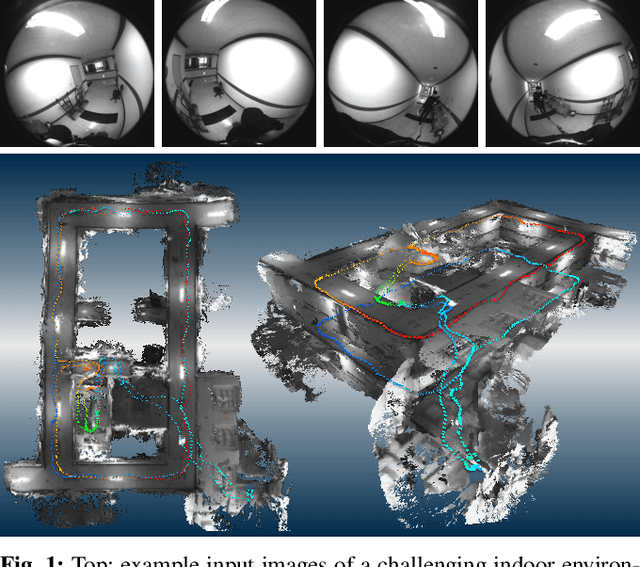
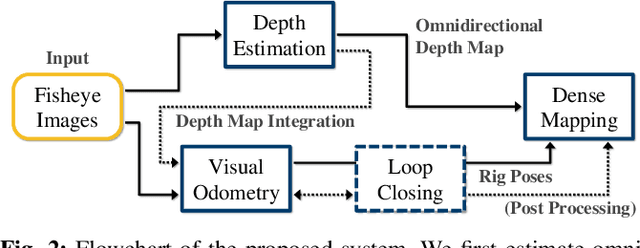
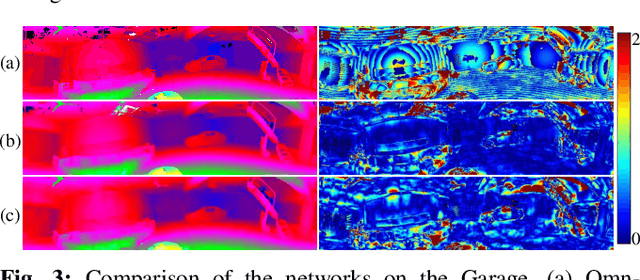
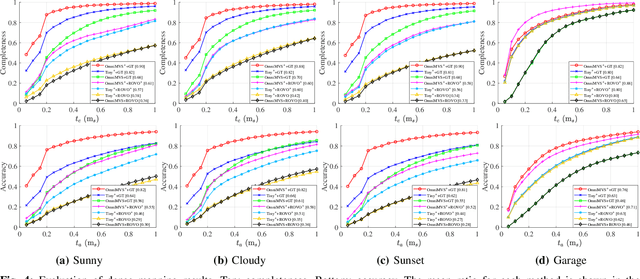
Abstract:In this paper, we present an omnidirectional localization and dense mapping system for a wide-baseline multiview stereo setup with ultra-wide field-of-view (FOV) fisheye cameras, which has a 360 degrees coverage of stereo observations of the environment. For more practical and accurate reconstruction, we first introduce improved and light-weighted deep neural networks for the omnidirectional depth estimation, which are faster and more accurate than the existing networks. Second, we integrate our omnidirectional depth estimates into the visual odometry (VO) and add a loop closing module for global consistency. Using the estimated depth map, we reproject keypoints onto each other view, which leads to a better and more efficient feature matching process. Finally, we fuse the omnidirectional depth maps and the estimated rig poses into the truncated signed distance function (TSDF) volume to acquire a 3D map. We evaluate our method on synthetic datasets with ground-truth and real-world sequences of challenging environments, and the extensive experiments show that the proposed system generates excellent reconstruction results in both synthetic and real-world environments.
Collaborative Training of Balanced Random Forests for Open Set Domain Adaptation
Feb 10, 2020

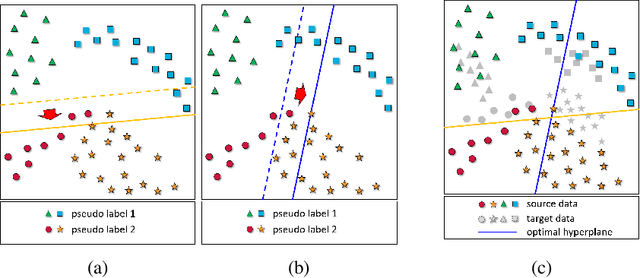

Abstract:In this paper, we introduce a collaborative training algorithm of balanced random forests with convolutional neural networks for domain adaptation tasks. In real scenarios, most domain adaptation algorithms face the challenges from noisy, insufficient training data and open set categorization. In such cases, conventional methods suffer from overfitting and fail to successfully transfer the knowledge of the source to the target domain. To address these issues, the following two techniques are proposed. First, we introduce the optimized decision tree construction method with convolutional neural networks, in which the data at each node are split into equal sizes while maximizing the information gain. It generates balanced decision trees on deep features because of the even-split constraint, which contributes to enhanced discrimination power and reduced overfitting problem. Second, to tackle the domain misalignment problem, we propose the domain alignment loss which penalizes uneven splits of the source and target domain data. By collaboratively optimizing the information gain of the labeled source data as well as the entropy of unlabeled target data distributions, the proposed CoBRF algorithm achieves significantly better performance than the state-of-the-art methods.
 Add to Chrome
Add to Chrome Add to Firefox
Add to Firefox Add to Edge
Add to Edge